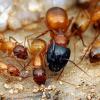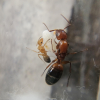Scientific Name: Pheidole bicarinata
Common Name: Big headed ants
Distribution: Widely distributed across the lower half of the United States.
Queen size: 5 mm
Worker size: Minor workers 2 mm, Majors 3 mm
Natural Habitat: This is a relatively common species that can be found in a wide range of habitats. They prefer sandy, well drained soils, though. Most common in warmer areas.
Circadian Activity: This species is very active at all times.
Mating Flight: Mating flights occur mostly between late June to late July. They fly on hot, humid nights, usually after good rains. Black light traps are the best way to attract newly mated queens.
Queen Founding Method: Fully-claustral
Monogyne or Polygyne: Strictly monogyne
Average time from egg to worker: Egg to Larvae = 14 days; Larvae to pupae = 10 days, Pupae to worker = 7 days. Very fast growing species if heated.
Recommended Temperature: It is best to keep these ants quite warm. Minimum 82 degrees F or 27 degrees C.
Recommended Humidity: This species prefers a moister nest, and they need plenty of drinking water at all times. It is amazing how quickly they drink down a liquid feeder.
Preferred Foods: These are not picky ants at all and relish all kinds of proteins. Mealworms, crickets, dubia roaches, and fruit flies are readily accepted. They also enjoy chopped or shelled seeds like hemp hearts and sesame.
Hibernation Details: This species does not strictly need to hibernate. When hibernating, use a gentle cooling around 50 degrees F or 10 degrees Celsius.
Escape Barrier Methods: These are real escape artists, so only the best barriers should be used. Fluon is preferable. Great care should be taken to seal up any gaps because the tiny workers can easily exploit them!
Difficulty rating: A very easy and fun species to keep. The only difficulty is their propensity to escape via tiny gaps, but this can be easily solved using 100% silicone to seal up escape points.
Bite and/or Sting rating: These do not sting. Their bite is barely noticeable.
Special Care or Interesting Notes: With plenty of heat and ample protein, colonies can quickly reach mature size and even produce alates within a year of founding. Colonies will cap off at a point, though, so they do not get too huge or unmanageable.
Additional Links:
AntWeb: https://www.antweb.o...t=allantwebants
Read about my colony here: https://www.formicul...-the-phatheads/
Information submitted by
ANTdrew
Edited by dspdrew, April 22 2022 - 10:54 PM.



















